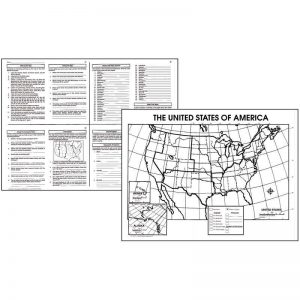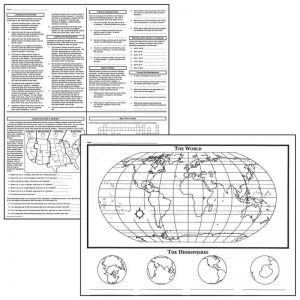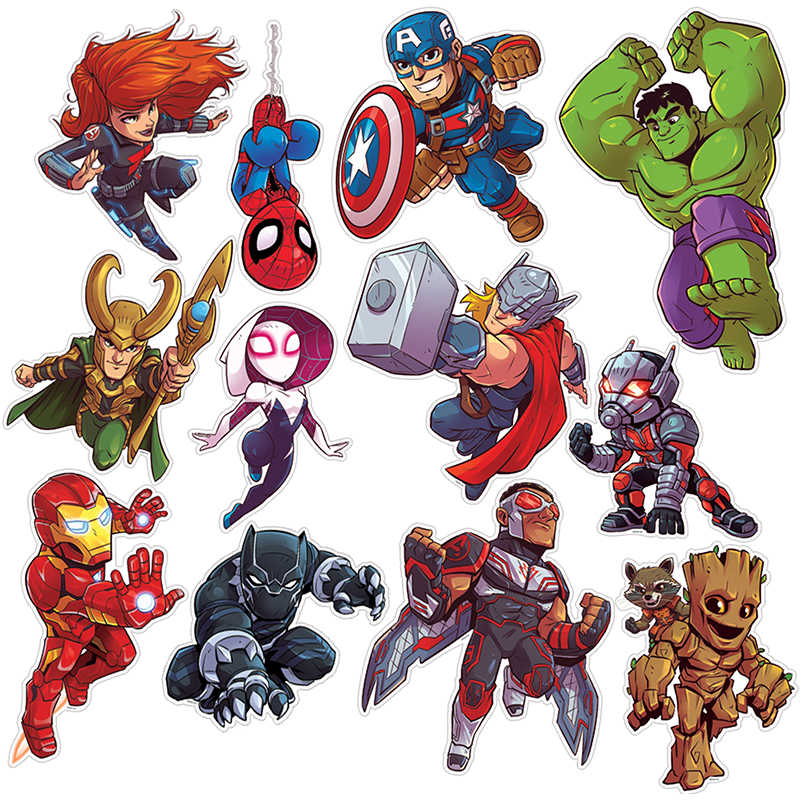Medieval Times
This book helps teach students about medieval times. It begins with the barbarian invasions of Europe that resulted in the fall of the Western Roman Empire, and it concludes with the events that led to the Renaissance. Students will enjoy reading and learning about such high-interest topics as feudalism, knighthood, castle life, legends and myths, medicine, the Crusades, and the Black Death. Each activity sheet presents clear and concise information and then tests students’ understanding with a variety of objective, subjective, and critical thinking questions and activities. Page 28 may be used as a review or to assess students’ knowledge of medieval times.
WORKSHEET & Sample PDF Activity
Sample PDF Activity
Introduction to the Middle Ages
Historians divide recorded history into three periods: ancient times, medieval times or the Middle Ages, and modern times. Ancient times range from the start of the Egyptian calendar about 4400 B.C. to the fall of the Roman Empire in 476 A.D. Medieval times span the years from the fall of Rome to Columbus’s arrival in America in 1492. For the sake of simplicity, medieval times are said to have begun in 500 and to have ended in 1500. All history after that time is referred to as modern times.
Italian scholars of the fifteenth century were the first to use the term Middle Ages to describe medieval times. They viewed their period of history, the Renaissance (a word meaning “a rebirth of learning”), as far more advanced than the Middle Ages. To them, the Middle Ages fell between the ancient civilizations of Greece and Rome, and the Renaissance.
The period of the Middle Ages was unlike any other time in history. There were few towns until the latter part of the age, and life centered around manors, the large estates of lords. Travel was dangerous during the Middle Ages because central governments were weak and there was little protection for those who moved from place to place. Civil power was in the hands of feudal lords, who were constantly warring among themselves. Caught in the middle of this turmoil were the common people. Most of these people were poor farmers called serfs. Society was so unsettled that the inhabitants of a manor often lived their entire lives within a five mile radius of where they were born.
During this difficult age, the Church played a dominant role. It was the one institution in Europe that stood for law and order, and it exerted tremendous power throughout the thousand-year period of the Middle Ages.
Circle the letter of each correct answer.
- The period of history known as ancient times is said to have begun with
a. the fall of the Roman Empire
b. the start of the Egyptian calendar
c. the founding of the Christian Church - The Middle Ages spanned approximately
a. 1000 years
b. 500 years
c. 4000 years - Modern times date from about the year
a. 1000
b. 476
c. 1500 - A manor was
a. a local church
b. a lord’s estate
c. a medieval town - The word renaissance means
a. rebirth of learning
b. time of troubles
c. decline in culture - The Renaissance is considered part of
a. ancient times
b. the Middle Ages
c. modern times - How was the role of the Church in the Middle Ages different from the role of
churches today?
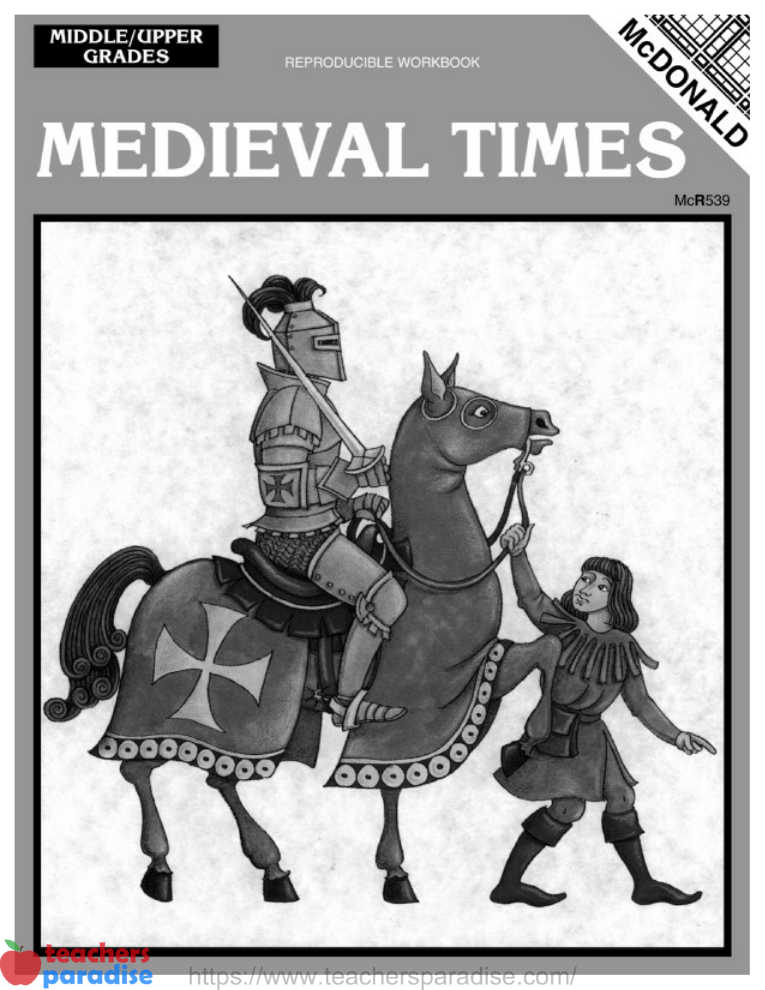
Barbarian Invasions
The period known as the Middle Ages began with the fall of the Roman Empire in the latter part of the fifth century. This fall took place gradually, resulting in a completely different way of life in Western Europe.
Until the third century A.D., the Roman Empire, for the most part, was at peace. Its government was stable, and its citizens were prosperous and productive. Rome’s policy of expansion, however, caused the empire to grow so large that it was difficult for Rome to govern the entire region. Taxes skyrocketed, morals declined, and the government grew corrupt. These factors made the empire weak and vulnerable to invasions by barbarian tribes to the north.
As the Roman Empire grew weaker, Germanic tribes north of the Rhine and Danube rivers began to invade it. They had chipped away at the fringes of the empire for many years, and in the third and fourth centuries they moved deeper into the area. Finally, they conquered the city of Rome itself in 476, and the great Roman Empire came to an end.
The barbarians that conquered Rome had little respect for learning and culture. They plundered and set fires at will, destroying libraries and works of art. The central government collapsed, and roads and bridges fell into ruin. Organized society as the Romans knew it disappeared, and a period known as the Dark Ages descended upon Europe. Out of this social disorder and confusion came the beginning of a new economic, social, and political system known as feudalism. Under feudalism, people offered their services to powerful lords in return for protection and land. Feudalism became more solidly established throughout Europe four hundred years later after the death of Charlemagne. Charlemagne had been the only Germanic ruler powerful enough to maintain some type of law and order in Europe.
- What event marks the end of ancient times?
- What factors brought about the fall of Rome?
- Why did law and order break down in Europe after the fall of Rome?
- How did feudalism differ from the system that existed while the Roman Empire was at its peak?
- What does the term “Dark Ages” imply?
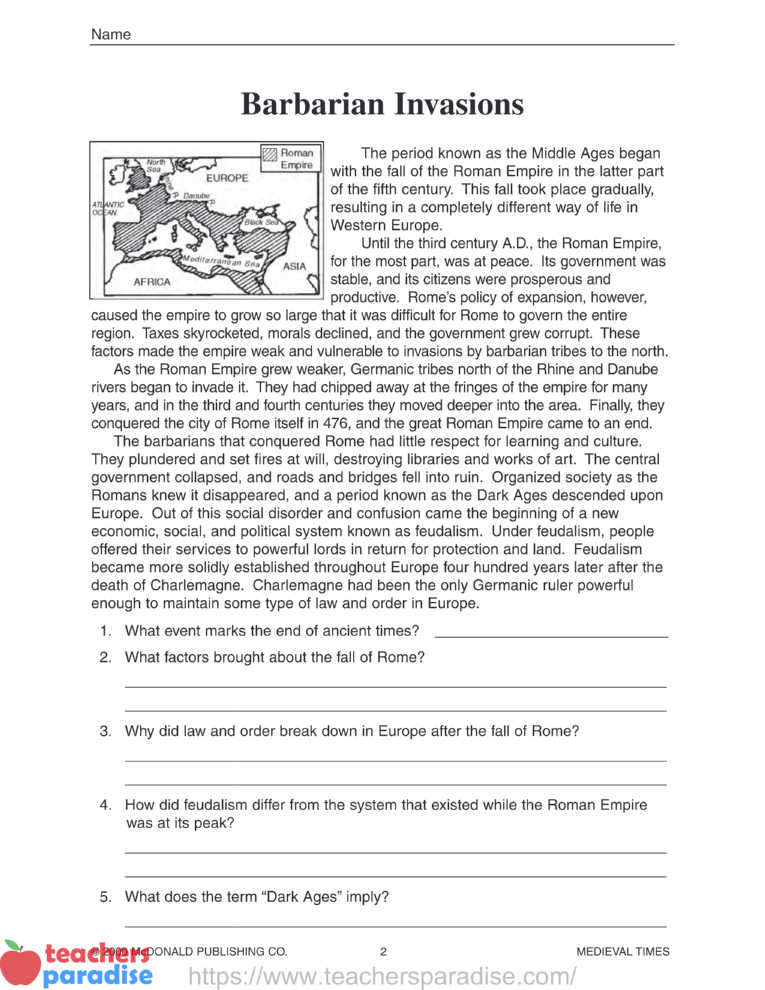
Table of Contents
1 Introduction to the Middle Ages
2 Barbarian Invasions
3 Charlemagne
4 The Vikings
5 The Feudal System
6 The Medieval Manor
7 Lords and Nobles
8 Serfs
9 Knights and Knighthood
10 Tournaments
11 Castle Life
12 Food and Clothing
13 The Medieval Church
14 The Powers of the Church
15 The Role of the Monasteries
16 Legends and Myths
17 Health and Medicine
18 The Crusades
19 Results of the Crusades
20 The Black Death
21 Medieval Fairs
22 Towns
23 Townspeople
24 Guilds
25 Schools and Universities
26 Art and Architecture
27 The End of the Middle Ages
28 Check Your Understanding

